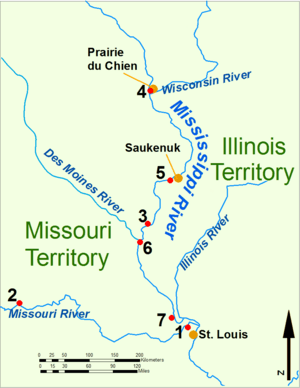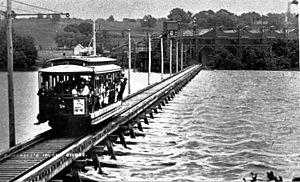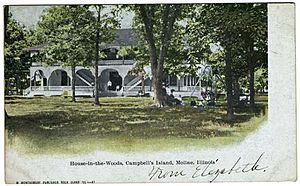Campbell's Island, Illinois facts for kids
Quick facts for kids
Campbell's Island
|
|
|---|---|
| Country | United States |
| State | Illinois |
| County | Rock Island County |
| Township | Hampton Township |
| Area | |
| • Total | 0.74 sq mi (1.91 km2) |
| • Land | 0.45 sq mi (1.17 km2) |
| • Water | 0.28 sq mi (0.73 km2) |
| Elevation | 571 ft (174 m) |
| Population
(2020)
|
|
| • Total | 275 |
| • Density | 605.73/sq mi (234.12/km2) |
| Time zone | UTC-6 (CST) |
| • Summer (DST) | UTC-5 (CDT) |
| FIPS code | 17-10786 |
Campbell's Island is a small island and community located in the Mississippi River. It's part of Hampton Township in Rock Island County, Illinois. The island is right next to the city of East Moline and is connected to it by a bridge. It's also home to the Campbell's Island State Memorial, a special historic site.


Contents
Island Population Facts
Campbell's Island is a small community. In 2020, about 275 people lived there.
| Historical population | |||
|---|---|---|---|
| Census | Pop. | %± | |
| 2020 | 275 | — | |
| U.S. Decennial Census | |||
Island History: Past Events
War of 1812 Battle
Campbell's Island was the location of an important battle during the War of 1812. This battle, called the Battle of Rock Island Rapids, happened on July 19, 1814. About 500 Sauk warriors, who were allies of the British Army, fought against American soldiers.
The American group was led by Lieutenant John Campbell. He was guiding three boats carrying military supplies up the Mississippi River. These supplies were for Fort Shelby. One boat had 42 people, including soldiers and their families. The other two boats carried 66 U.S. Rangers.
The British-allied Native Americans attacked the boats in their canoes. They were so strong that they forced Lieutenant Campbell's group to turn back. The Americans lost 8 soldiers and had 16 wounded from the 1st Regiment. Four Rangers were killed and 8 were wounded. This victory helped the Sauk people keep control of the Quad Cities area for nearly 20 more years.
Today, the Campbell's Island State Memorial, built in 1908, remembers this battle.
However, more American settlers and families moved into northwestern Illinois. In 1832, the Sauk were defeated in the Black Hawk War. After this, the Quad Cities area was opened for new settlements. Campbell's Island was then named after John Campbell, even though he lost the 1814 battle.
Early 1900s: A Popular Resort
Around the year 1900, a streetcar company bought Campbell's Island. They planned to build a large amusement park there. In 1904, the first streetcar bridge was built. It was placed on top of a dam that the Army Corps of Engineers had built earlier.
Campbell's Island became a very popular vacation spot in the early to mid-1900s. People could rent small cottages for their holidays. Some wealthier families even built their own summer cabins. Extra streetcars ran to the island in the mornings and afternoons. This helped seasonal residents travel to and from their jobs in the nearby cities.
A famous building called the House-In-the-Woods was built in 1904. It had a dining area on the first floor and a ballroom on the second floor where orchestras played music. A fire destroyed it in 1911, but it was rebuilt the next spring. Later, it was renamed The Campbell's Island Inn. In the late 1950s, the inn became the Ship's Wheel Boat Club. It included a dock for visitors and a marina for boats. The boat club and marina survived a flood in 1965 but burned down in 1979.
Campbell's Island Today
The size and shape of Campbell's Island have changed over time. This is because the powerful Mississippi River can add land or wash it away. Today, the island is about 1.25 miles (2 kilometers) long and 0.5 miles (0.8 kilometers) wide.
It is now a suburban community. Homes are built along a road that circles the island. Because Campbell's Island is low, it can sometimes flood. Many homes on the island are built on stilts or raised high to protect them from high water, like during the Great Flood of 1993. The bridge connecting the island to East Moline was first built in 1938 and completely rebuilt in 1999.
The "Rock Island Rapids," which was a shallow, rocky part of the Mississippi River that gave the 1814 battle its name, no longer exists. In 1934, a large structure called Lock and Dam No. 15 was built several miles downstream from Campbell's Island, which changed the river flow and made the rapids disappear.




